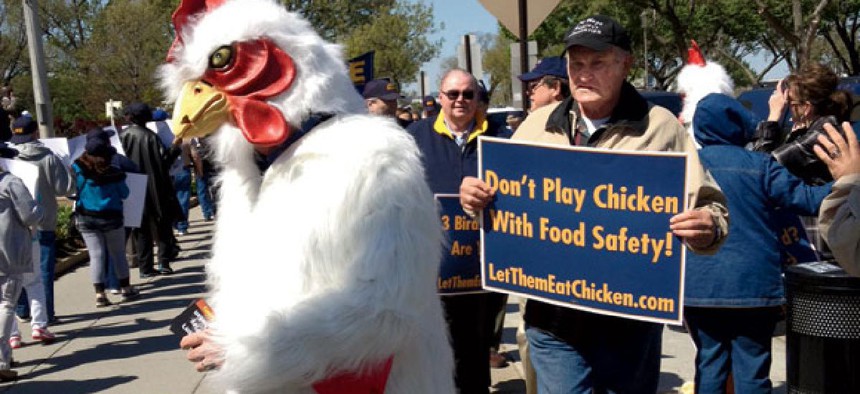
Amanda Palleschi/Govexec.com
Food Safety On the Line
Critics say using more private sector poultry inspectors could weaken quality checks.
Before he became an advocate for food inspection workers and a proponent for consumer food safety, Stan Painter worked in commercial slaughterhouses as a chicken grader and quality control agent. He remembers seeing workers put condemned meat back on the line labeled as “edible product,” and he recalls managers telling rank-and-file employees to keep quiet about contamination. “If the plant tells you to falsify the paperwork, and you don’t falsify the paperwork, they are going to fire you,” he says.
He does not believe all slaughterhouses are bad and accepts it’s a tall order to execute best practices on every bird, every time. But Painter and many of the federal inspectors he represents as chairman of the American Federation of Government Employees National Joint Council of Food Inspection Locals believe an Agriculture Department proposal aimed at saving money could make an already imperfect system worse.
USDA officials want to expand a program that allows processing plants to replace some federal poultry inspectors with their own hires. The endeavor began as a pilot at 20 chicken and five turkey slaughterhouses in the Southeast and Southwest in 1998. In January, USDA’s Food Safety and Inspection Service proposed adding about 200 facilities, mostly in the same regions.
Opponents argue the program jeopardizes safety in part by hastening the chicken inspection process. Under traditional methods, birds move down the line at a rate of 140 per minute, with two inspectors on each side examining them. Under the pilot, this would increase to 175 birds per minute and federal inspectors would not be involved until later in the process, as a final quality check. The program’s expansion could result in the loss of 800 to 1,000 federal inspector jobs through attrition, though this is not something union and consumer food safety group protesters chose to highlight when they took to bullhorns and donned chicken costumes outside USDA headquarters in March. Instead, they emphasized the food safety concerns.Opponents of the pilot say the remaining federal inspectors would be permitted to take only 80 carcasses off the line for closer inspection per shift, from among hundreds of thousands. But Ali Almanza, Food Safety Inspection Service administrator, says an inspector can stop the line at any time. In fact, a routine sampling requirement actually increases the number of carcasses given a second look under the pilot program, he says.
Opponents also express concern about the qualifications of their would-be commercial replacements. Federal inspectors receive about three years of training to examine carcasses for fecal matter, disease and other contamination that can lead to food-borne illnesses. Some fear private inspectors would not receive adequate training. But Almanza said under the pilot, federal and private inspectors are “very knowledgeable” and would receive four additional weeks of training.
Still, the new process could weaken critical controls, says Tony Corbo, a legislative representative for the consumer rights group Food and Water Watch. “Whether you’re trained or not, you’re not going to be able to catch stuff,” he says. USDA argues the change would be good for both consumers and taxpayers. According to March congressional testimony by Undersecretary for Food Safety Elisabeth Hagen, expanding the pilot would save taxpayers more than $90 million during the first three years and could lower production costs by $256 million annually.
Officials also say the current poultry inspection system is outdated. Like Painter, Almanza is a former FSIS inspector. In his view, the poultry inspection process hasn’t evolved much since the Eisenhower administration, and should change to reflect the increasing uniformity of slaughtered chickens and decreased risk of contamination. “It’s like having 99 [white] pingpong balls on a table and one black one,” Almanza says. “[Defects] are that easy to pick out because there is so much uniformity.”
The debate is more than a decade old: AFGE and other groups challenged FSIS when the pilot began, arguing it violated federal regulations requiring federal inspectors rather than plant employees to conduct final examinations. The Court of Appeals for the District of Columbia Circuit ultimately ruled that a modified version of the original pilot complied with federal regulations.
Under the compromise, FSIS can require faster line speeds since private employees must sort defective carcasses prior to federal inspection. Regulations stipulate what must be inspected and by whom, but do not clearly lay out “exactly what an inspection is,” documents from the appeals court stated.
FSIS and watchdog groups like the Government Accountability Project and Food and Water Watch provide contradictory analyses of the pilot. Food and Water Watch’s review, conducted via Freedom of Information Act requests, finds some of the plants in the pilot let many birds with defects through the line; a government-sanctioned analysis points instead to lower rates of fecal contamination at pilot plants versus traditional ones.
The agency is gathering public comment on the expansion. If officials decide to move forward, then the changes will take at least one year to implement and plants will be able to choose whether or not to sign up.
Phyllis McKelvey, a retired USDA poultry inspector who worked on the first pilot project in Guntersville, Ala., said she believes the companies involved did their best to maintain quality control standards. But she is concerned that might not continue if the pilot becomes policy.
“All they do on the pilot is they sit and watch the birds go flying by,” she says. The program is “going to be a total nightmare” if it is expanded nationwide, she adds.
NEXT STORY: Around Government






